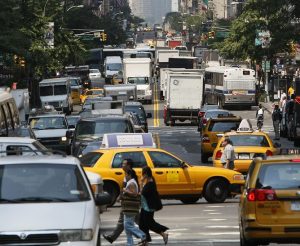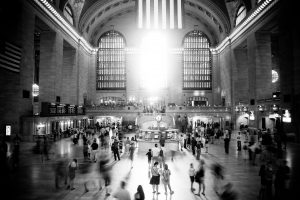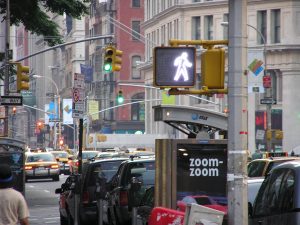 Here is what it’s like to live in New York City: Every day I walk a maze of sidewalks and dodge a never-ending stream of people, cars, bicycles, scooters, dogs, strollers, and pigeons. I navigate subway transfers with efficiency and precision, knowing the exact spot to stand on each platform to minimize my time in transit. I step quickly, weaving around mailboxes, trees, and, on one especially trying morning, a whole class of students with rolling suitcases on their way to LaGuardia.
Here is what it’s like to live in New York City: Every day I walk a maze of sidewalks and dodge a never-ending stream of people, cars, bicycles, scooters, dogs, strollers, and pigeons. I navigate subway transfers with efficiency and precision, knowing the exact spot to stand on each platform to minimize my time in transit. I step quickly, weaving around mailboxes, trees, and, on one especially trying morning, a whole class of students with rolling suitcases on their way to LaGuardia.
Every day I am tempted to ruminate on how the people around me are continually inconveniencing me, and not only that—they fail to realize the extent to which they are inconveniencing me. In a densely populated city that relies heavily on pedestrian traffic and public transportation, blocking someone’s path—be it by dawdling, pausing in the middle of the sidewalk, holding a subway door, or cutting someone off while distracted by a glowing iPhone screen—can create a major bottleneck and cause delays for hundreds of other people. Getting around the city efficiently requires a particular kind of spatial awareness that many people, especially tourists, don’t quite grasp. Even locals have trouble sometimes with respecting one another’s time and personal space. The unspoken rule of riding in a packed subway car—and I mean a really packed subway car, where there’s hardly any space to breathe—is to ignore everyone else around you, pretend that another person’s elbow is not digging into your waist, and wait for it to be over. But several times, I’ve overheard arguments break out among other passengers as people clamor for more space; sometimes these escalate into screaming matches as the train jerks and jostles us around.
 In these crowded situations, it seems there is always at least one person on the verge of losing it. But why? If this happens day after day—and it does—why aren’t we prepared to deal with it every time? Why does it surprise or anger us when we get caught behind a tourist at Grand Central who doesn’t know how to swipe their Metrocard, or when a truck pulls too far forward and blocks the crosswalk as we approach, forcing us to wait an entire thirty more seconds to cross the street?
In these crowded situations, it seems there is always at least one person on the verge of losing it. But why? If this happens day after day—and it does—why aren’t we prepared to deal with it every time? Why does it surprise or anger us when we get caught behind a tourist at Grand Central who doesn’t know how to swipe their Metrocard, or when a truck pulls too far forward and blocks the crosswalk as we approach, forcing us to wait an entire thirty more seconds to cross the street?
In a city of so many options, our time seems so precious, and it’s easy to feel like we’re always missing out on something that’s going on. It may be tempting to think that we could do everything and get everywhere we wanted within a given day, if not for the people who block our path and make our journeys slower. But the reality is that we are all inconveniencing each other. The great volume of people who create so many interesting things to do and see within this city also clog its streets and avenues. As much as I can become frustrated when others stand in my way, I’m sure that I, too, have inadvertently inconvenienced many of my fellow New Yorkers as I go about my daily commute. There’s no scale to determine whose needs are more urgent or important—we’re all busy, we all have somewhere to go, and we all try to push and shove our way to the front.
 There are several lessons to be learned here: first of all, the importance of leaving flex space in our schedules to plan for inevitable delays. When we overschedule our lives and try to fit too much into our day, we forget to acknowledge that we are not ultimately in control, and we can’t do everything. If we instead leave time for delays, we can allow ourselves to be more relaxed and more focused on the commitments we keep. Every day is a bit of an adventure, and we should be prepared to encounter some surprises.
There are several lessons to be learned here: first of all, the importance of leaving flex space in our schedules to plan for inevitable delays. When we overschedule our lives and try to fit too much into our day, we forget to acknowledge that we are not ultimately in control, and we can’t do everything. If we instead leave time for delays, we can allow ourselves to be more relaxed and more focused on the commitments we keep. Every day is a bit of an adventure, and we should be prepared to encounter some surprises.
A second lesson from commuting in New York is how other people can reveal our own faults. Mother Angelica once said, “If it wasn’t for people, we could all be holy.” How true this sounds to the New Yorker! If only, we think, we could enjoy the wonders of Manhattan without the throngs of people that surround us—we would be so much better behaved! But then what would Manhattan be, if not for its people? Do we see these crowds as annoying obstacles in our way, or as the group of precious, individual souls that they truly are? Do we allow ourselves to forget their humanity when they cause us difficulties, or do we take part in the beautiful struggle to love, to forgive, and to see one another as brothers and sisters?
 We all face circumstances from time to time when other people test our patience. But do we choose to use these experiences as opportunities to grow in empathy, humility, and restraint? Or do we allow them to distract us and upset our sense of peace?
We all face circumstances from time to time when other people test our patience. But do we choose to use these experiences as opportunities to grow in empathy, humility, and restraint? Or do we allow them to distract us and upset our sense of peace?
Dealing with the inconveniences of living in a crowded city is teaching me, bit by bit, to let go of my own self-importance, be mindful of the needs of others, and assume the best of each person I meet. It’s teaching me that I can’t control every minute of my life, that my own plans will often be wrecked, and I need to have patience and go with the flow. It’s teaching me to maintain a sense of peace despite the many trials I will encounter in this world, and ultimately, it’s teaching me to do a better job of loving my neighbor.
—
Header: Photo by Beraldo Leal / CC BY 2.0
1. ILMRT / CC BY-SA 3.0
2. Alwynloh, Grand Central Terminal / CC BY-SA 4.0
3. Public Domain
4. Thomas Sørenes, Waiting / CC BY 2.0





